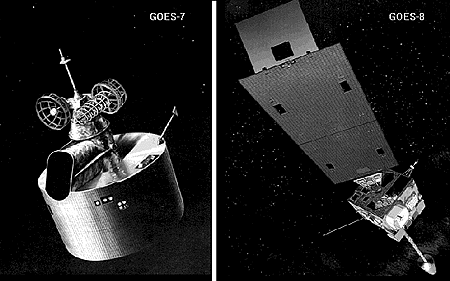
|
The first satellite in the GOES program (GOES-1) was launched on October 16, 1975 and quickly became an essential component of services provided by the National Weather Service. From the earliest days of the GOES program, implementing satellite imagery to perform such tasks as tracking hurricanes and volcano ash, as well as deriving cloud drift winds and their temperatures, were (and still are today) used by operational forecast centers to help with analyses in data sparse areas.
The newer satellites have benefited from the experiences of the other seven (GOES-1 through GOES-7) and results are shown through their improved capabilities. GOES-7 (pictured below) was only recently discontinued in 1995 and replaced by the more advanced GOES-9.

Resource: GOES-8 Tutorial of the NOAA-NESDIS RAMM Group
To date, a total of ten GOES satellites have been launched into orbit. Over the years as new technologies became available, the design of the GOES satellites changed accordingly to best make use of these new innovations. Below is a table that reconstructs the history of the GOES Program.
| Name | Launch dates | Significant milestones |
|---|---|---|
| GOES-1 | Oct. 16,1975 | Geosynchronous satellites dedicated to meteorology. GOES data became a critical part of National Weather Service |
| GOES-2 | June 6,1977 | |
| GOES-3 | June 16,1978 | |
| GOES-4 | Sept. 9,1980 | Added Atmospheric Sounder to the VISSR; however, imaging and sounding could not be done at the same time. |
| GOES-5 | May 22,1981 | |
| GOES-6 | April 28, 1983 | |
| GOES-7 | Feb. 26, 1987 |
GOES-1, GOES-2, and GOES-3 were constructed by Aeronautics Ford, and the remaining four were built by the Hughes Aircraft Company.
Selected Text Provided By: GOES Mission Overview and The Goes Users Guide.

introduction |
|

current GOES |




